The Impact of Social Determinants on Health: Syrian Refugees
VerifiedAdded on 2022/11/30
|15
|4496
|298
Report
AI Summary
This report examines the impact of social determinants of health (SDH), focusing on income and employment, on the health outcomes of Syrian refugees. It begins by defining globalization and its impact on health, emphasizing the World Health Organization's (WHO) approach to SDH. The report identifies income and employment as key SDHs affecting the Syrian refugee population, highlighting their vulnerability due to displacement and limited opportunities. It analyzes how unemployment and poor working conditions negatively affect this group, leading to health disparities, including increased rates of non-communicable diseases and mental health issues like anxiety and PTSD. The report provides statistics on health disparities and unemployment among Syrian refugees, emphasizing the need for strategies to improve their employment prospects and overall well-being. It concludes by advocating for policies that address basic needs and promote social integration to enhance the health and employability of Syrian refugees, aligning with WHO's recommendations for addressing health inequities.
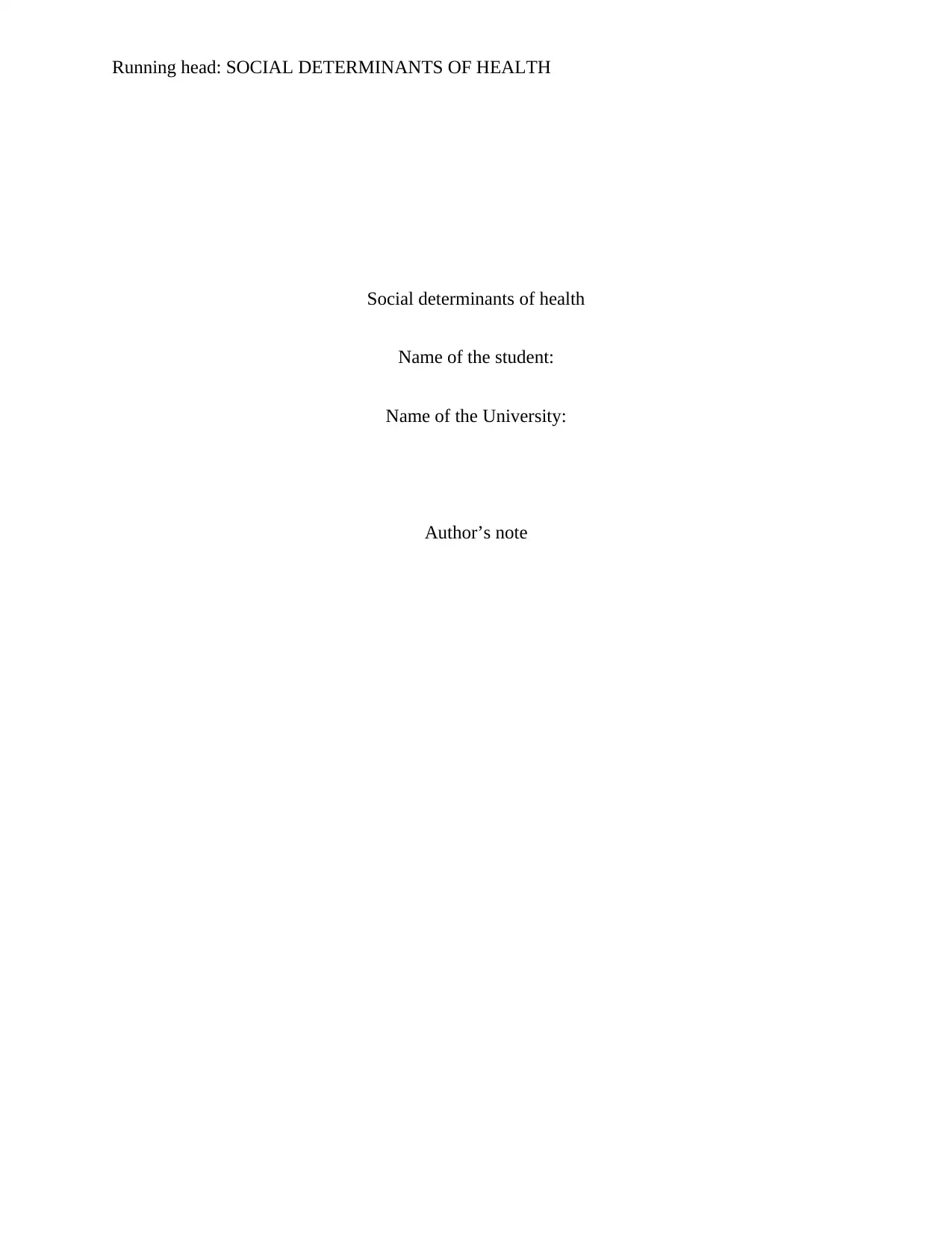
Running head: SOCIAL DETERMINANTS OF HEALTH
Social determinants of health
Name of the student:
Name of the University:
Author’s note
Social determinants of health
Name of the student:
Name of the University:
Author’s note
Paraphrase This Document
Need a fresh take? Get an instant paraphrase of this document with our AI Paraphraser
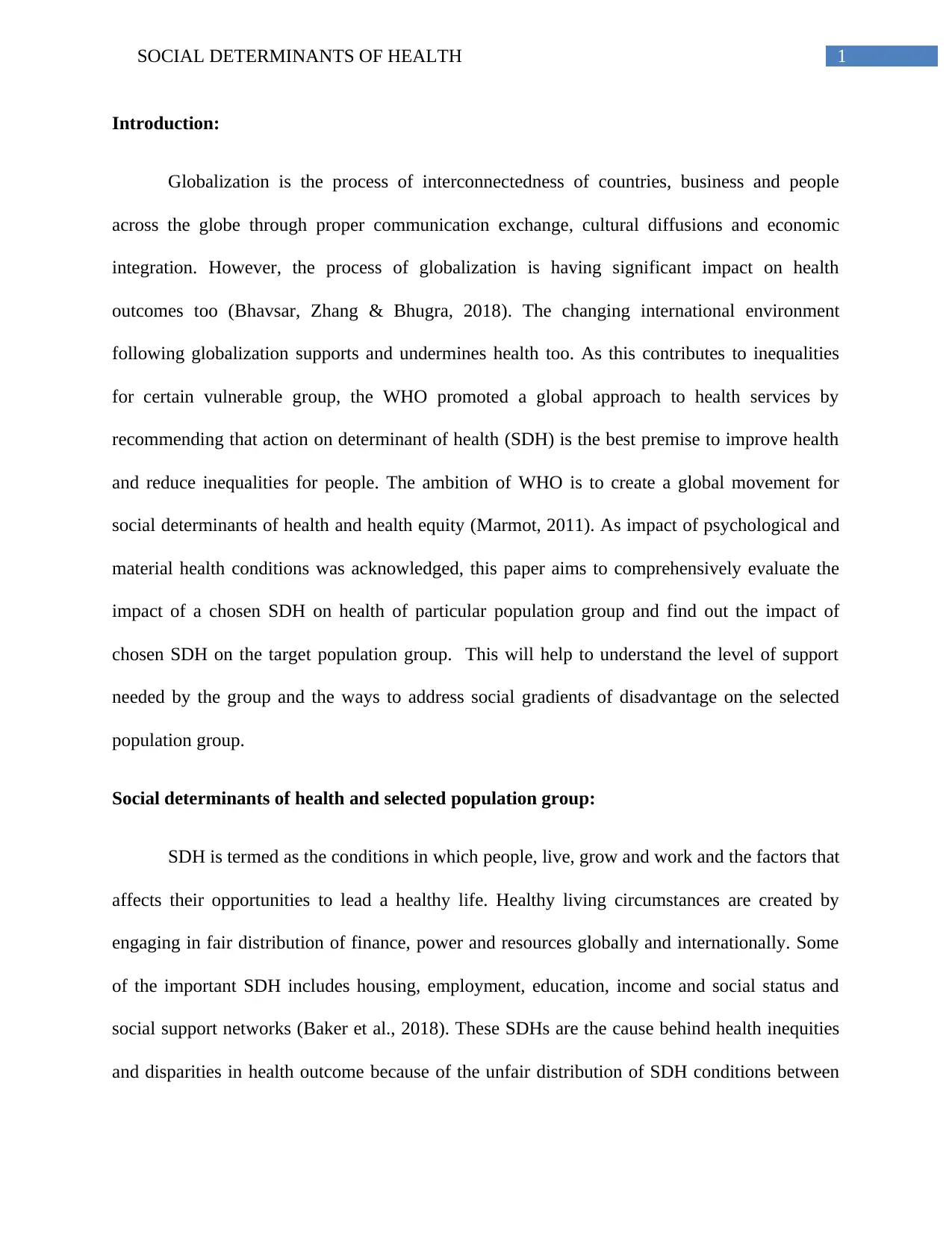
1SOCIAL DETERMINANTS OF HEALTH
Introduction:
Globalization is the process of interconnectedness of countries, business and people
across the globe through proper communication exchange, cultural diffusions and economic
integration. However, the process of globalization is having significant impact on health
outcomes too (Bhavsar, Zhang & Bhugra, 2018). The changing international environment
following globalization supports and undermines health too. As this contributes to inequalities
for certain vulnerable group, the WHO promoted a global approach to health services by
recommending that action on determinant of health (SDH) is the best premise to improve health
and reduce inequalities for people. The ambition of WHO is to create a global movement for
social determinants of health and health equity (Marmot, 2011). As impact of psychological and
material health conditions was acknowledged, this paper aims to comprehensively evaluate the
impact of a chosen SDH on health of particular population group and find out the impact of
chosen SDH on the target population group. This will help to understand the level of support
needed by the group and the ways to address social gradients of disadvantage on the selected
population group.
Social determinants of health and selected population group:
SDH is termed as the conditions in which people, live, grow and work and the factors that
affects their opportunities to lead a healthy life. Healthy living circumstances are created by
engaging in fair distribution of finance, power and resources globally and internationally. Some
of the important SDH includes housing, employment, education, income and social status and
social support networks (Baker et al., 2018). These SDHs are the cause behind health inequities
and disparities in health outcome because of the unfair distribution of SDH conditions between
Introduction:
Globalization is the process of interconnectedness of countries, business and people
across the globe through proper communication exchange, cultural diffusions and economic
integration. However, the process of globalization is having significant impact on health
outcomes too (Bhavsar, Zhang & Bhugra, 2018). The changing international environment
following globalization supports and undermines health too. As this contributes to inequalities
for certain vulnerable group, the WHO promoted a global approach to health services by
recommending that action on determinant of health (SDH) is the best premise to improve health
and reduce inequalities for people. The ambition of WHO is to create a global movement for
social determinants of health and health equity (Marmot, 2011). As impact of psychological and
material health conditions was acknowledged, this paper aims to comprehensively evaluate the
impact of a chosen SDH on health of particular population group and find out the impact of
chosen SDH on the target population group. This will help to understand the level of support
needed by the group and the ways to address social gradients of disadvantage on the selected
population group.
Social determinants of health and selected population group:
SDH is termed as the conditions in which people, live, grow and work and the factors that
affects their opportunities to lead a healthy life. Healthy living circumstances are created by
engaging in fair distribution of finance, power and resources globally and internationally. Some
of the important SDH includes housing, employment, education, income and social status and
social support networks (Baker et al., 2018). These SDHs are the cause behind health inequities
and disparities in health outcome because of the unfair distribution of SDH conditions between
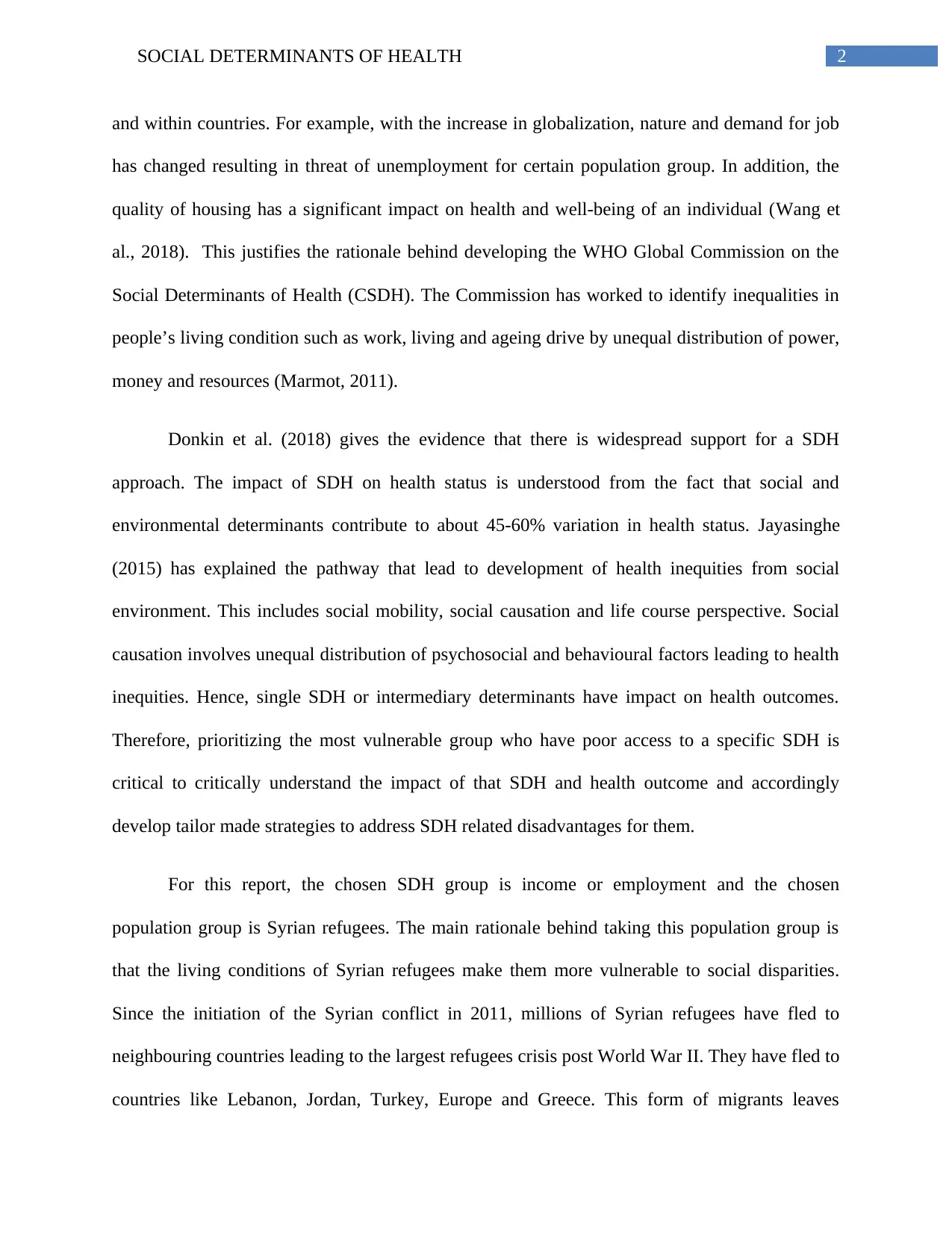
2SOCIAL DETERMINANTS OF HEALTH
and within countries. For example, with the increase in globalization, nature and demand for job
has changed resulting in threat of unemployment for certain population group. In addition, the
quality of housing has a significant impact on health and well-being of an individual (Wang et
al., 2018). This justifies the rationale behind developing the WHO Global Commission on the
Social Determinants of Health (CSDH). The Commission has worked to identify inequalities in
people’s living condition such as work, living and ageing drive by unequal distribution of power,
money and resources (Marmot, 2011).
Donkin et al. (2018) gives the evidence that there is widespread support for a SDH
approach. The impact of SDH on health status is understood from the fact that social and
environmental determinants contribute to about 45-60% variation in health status. Jayasinghe
(2015) has explained the pathway that lead to development of health inequities from social
environment. This includes social mobility, social causation and life course perspective. Social
causation involves unequal distribution of psychosocial and behavioural factors leading to health
inequities. Hence, single SDH or intermediary determinants have impact on health outcomes.
Therefore, prioritizing the most vulnerable group who have poor access to a specific SDH is
critical to critically understand the impact of that SDH and health outcome and accordingly
develop tailor made strategies to address SDH related disadvantages for them.
For this report, the chosen SDH group is income or employment and the chosen
population group is Syrian refugees. The main rationale behind taking this population group is
that the living conditions of Syrian refugees make them more vulnerable to social disparities.
Since the initiation of the Syrian conflict in 2011, millions of Syrian refugees have fled to
neighbouring countries leading to the largest refugees crisis post World War II. They have fled to
countries like Lebanon, Jordan, Turkey, Europe and Greece. This form of migrants leaves
and within countries. For example, with the increase in globalization, nature and demand for job
has changed resulting in threat of unemployment for certain population group. In addition, the
quality of housing has a significant impact on health and well-being of an individual (Wang et
al., 2018). This justifies the rationale behind developing the WHO Global Commission on the
Social Determinants of Health (CSDH). The Commission has worked to identify inequalities in
people’s living condition such as work, living and ageing drive by unequal distribution of power,
money and resources (Marmot, 2011).
Donkin et al. (2018) gives the evidence that there is widespread support for a SDH
approach. The impact of SDH on health status is understood from the fact that social and
environmental determinants contribute to about 45-60% variation in health status. Jayasinghe
(2015) has explained the pathway that lead to development of health inequities from social
environment. This includes social mobility, social causation and life course perspective. Social
causation involves unequal distribution of psychosocial and behavioural factors leading to health
inequities. Hence, single SDH or intermediary determinants have impact on health outcomes.
Therefore, prioritizing the most vulnerable group who have poor access to a specific SDH is
critical to critically understand the impact of that SDH and health outcome and accordingly
develop tailor made strategies to address SDH related disadvantages for them.
For this report, the chosen SDH group is income or employment and the chosen
population group is Syrian refugees. The main rationale behind taking this population group is
that the living conditions of Syrian refugees make them more vulnerable to social disparities.
Since the initiation of the Syrian conflict in 2011, millions of Syrian refugees have fled to
neighbouring countries leading to the largest refugees crisis post World War II. They have fled to
countries like Lebanon, Jordan, Turkey, Europe and Greece. This form of migrants leaves
⊘ This is a preview!⊘
Do you want full access?
Subscribe today to unlock all pages.

Trusted by 1+ million students worldwide
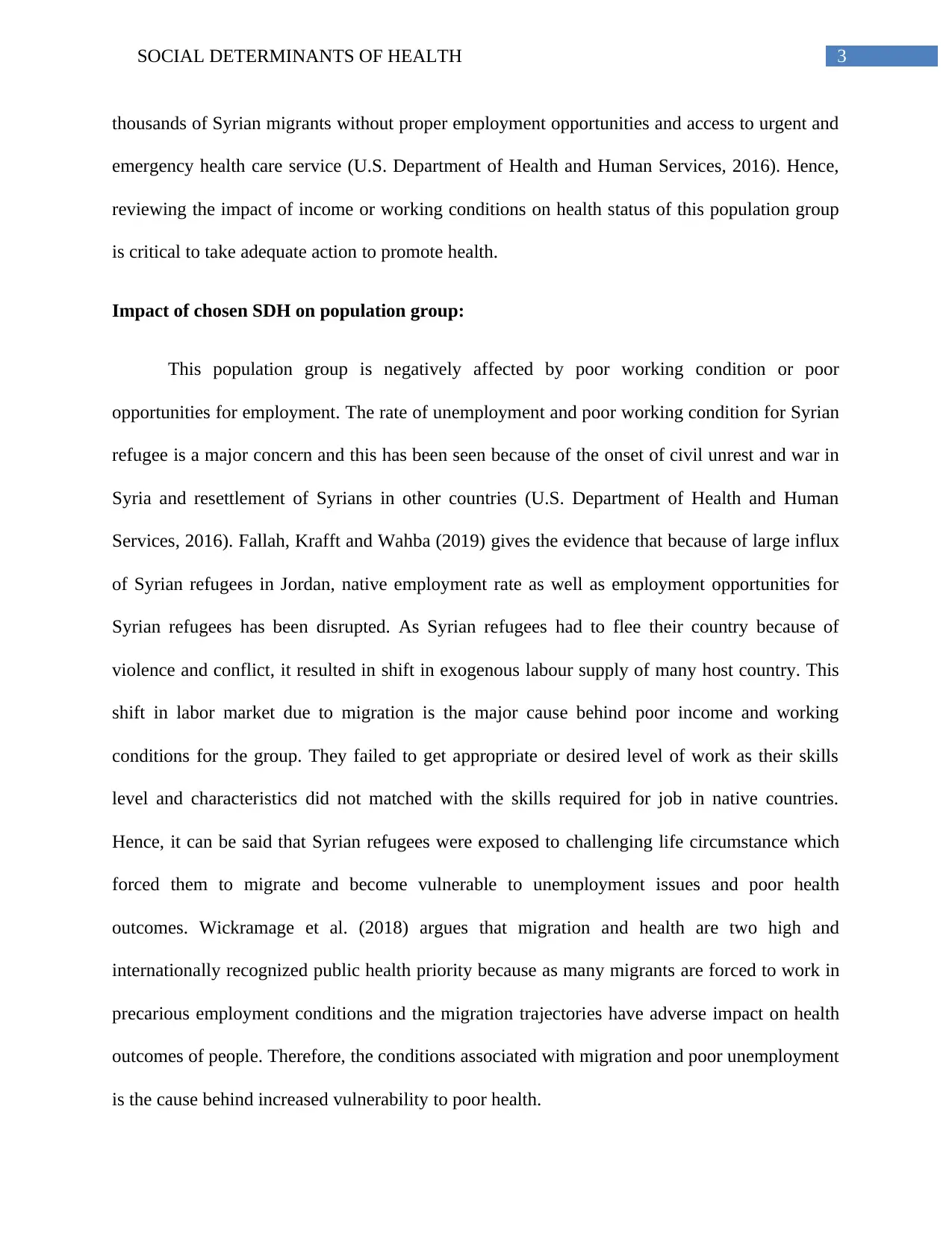
3SOCIAL DETERMINANTS OF HEALTH
thousands of Syrian migrants without proper employment opportunities and access to urgent and
emergency health care service (U.S. Department of Health and Human Services, 2016). Hence,
reviewing the impact of income or working conditions on health status of this population group
is critical to take adequate action to promote health.
Impact of chosen SDH on population group:
This population group is negatively affected by poor working condition or poor
opportunities for employment. The rate of unemployment and poor working condition for Syrian
refugee is a major concern and this has been seen because of the onset of civil unrest and war in
Syria and resettlement of Syrians in other countries (U.S. Department of Health and Human
Services, 2016). Fallah, Krafft and Wahba (2019) gives the evidence that because of large influx
of Syrian refugees in Jordan, native employment rate as well as employment opportunities for
Syrian refugees has been disrupted. As Syrian refugees had to flee their country because of
violence and conflict, it resulted in shift in exogenous labour supply of many host country. This
shift in labor market due to migration is the major cause behind poor income and working
conditions for the group. They failed to get appropriate or desired level of work as their skills
level and characteristics did not matched with the skills required for job in native countries.
Hence, it can be said that Syrian refugees were exposed to challenging life circumstance which
forced them to migrate and become vulnerable to unemployment issues and poor health
outcomes. Wickramage et al. (2018) argues that migration and health are two high and
internationally recognized public health priority because as many migrants are forced to work in
precarious employment conditions and the migration trajectories have adverse impact on health
outcomes of people. Therefore, the conditions associated with migration and poor unemployment
is the cause behind increased vulnerability to poor health.
thousands of Syrian migrants without proper employment opportunities and access to urgent and
emergency health care service (U.S. Department of Health and Human Services, 2016). Hence,
reviewing the impact of income or working conditions on health status of this population group
is critical to take adequate action to promote health.
Impact of chosen SDH on population group:
This population group is negatively affected by poor working condition or poor
opportunities for employment. The rate of unemployment and poor working condition for Syrian
refugee is a major concern and this has been seen because of the onset of civil unrest and war in
Syria and resettlement of Syrians in other countries (U.S. Department of Health and Human
Services, 2016). Fallah, Krafft and Wahba (2019) gives the evidence that because of large influx
of Syrian refugees in Jordan, native employment rate as well as employment opportunities for
Syrian refugees has been disrupted. As Syrian refugees had to flee their country because of
violence and conflict, it resulted in shift in exogenous labour supply of many host country. This
shift in labor market due to migration is the major cause behind poor income and working
conditions for the group. They failed to get appropriate or desired level of work as their skills
level and characteristics did not matched with the skills required for job in native countries.
Hence, it can be said that Syrian refugees were exposed to challenging life circumstance which
forced them to migrate and become vulnerable to unemployment issues and poor health
outcomes. Wickramage et al. (2018) argues that migration and health are two high and
internationally recognized public health priority because as many migrants are forced to work in
precarious employment conditions and the migration trajectories have adverse impact on health
outcomes of people. Therefore, the conditions associated with migration and poor unemployment
is the cause behind increased vulnerability to poor health.
Paraphrase This Document
Need a fresh take? Get an instant paraphrase of this document with our AI Paraphraser
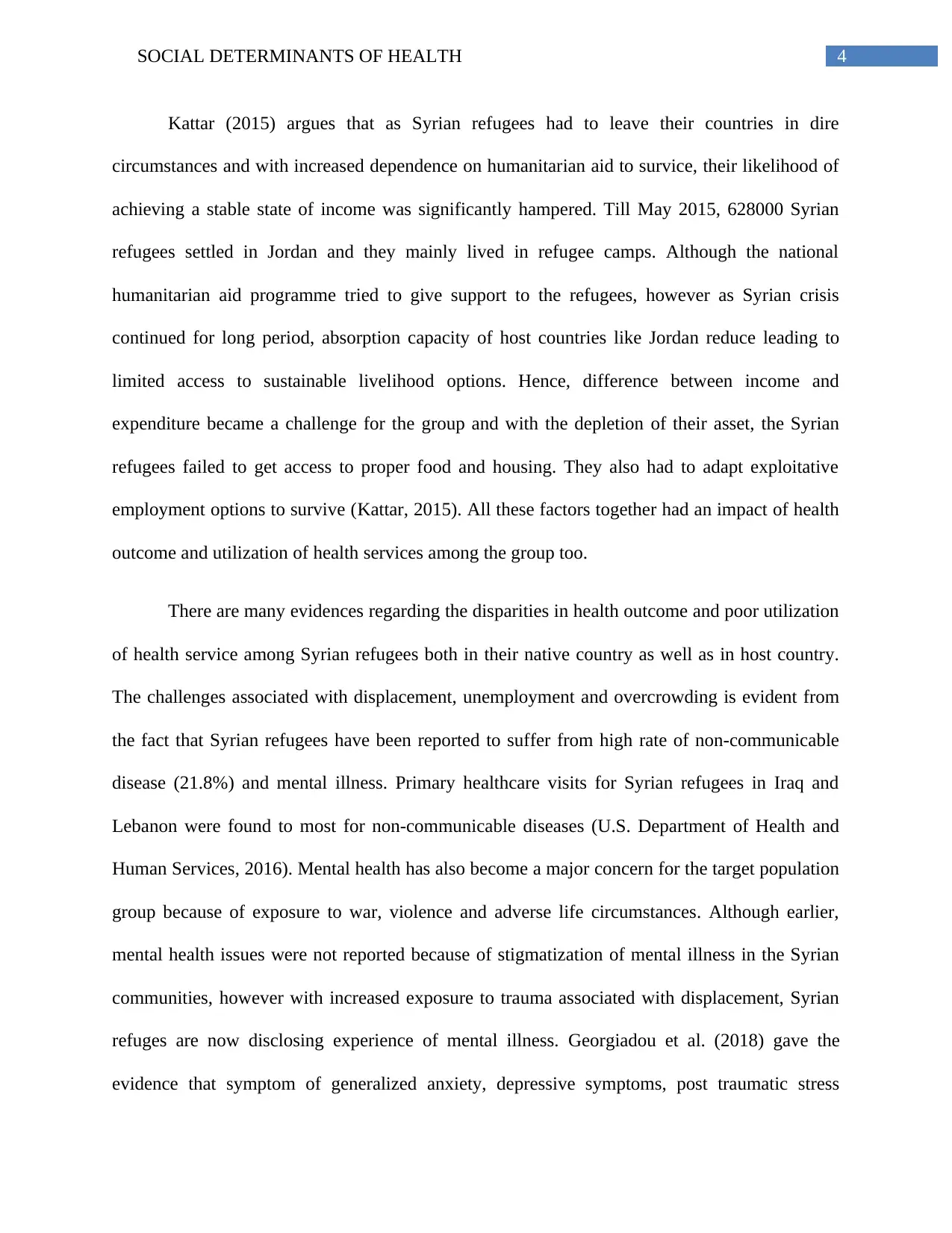
4SOCIAL DETERMINANTS OF HEALTH
Kattar (2015) argues that as Syrian refugees had to leave their countries in dire
circumstances and with increased dependence on humanitarian aid to survice, their likelihood of
achieving a stable state of income was significantly hampered. Till May 2015, 628000 Syrian
refugees settled in Jordan and they mainly lived in refugee camps. Although the national
humanitarian aid programme tried to give support to the refugees, however as Syrian crisis
continued for long period, absorption capacity of host countries like Jordan reduce leading to
limited access to sustainable livelihood options. Hence, difference between income and
expenditure became a challenge for the group and with the depletion of their asset, the Syrian
refugees failed to get access to proper food and housing. They also had to adapt exploitative
employment options to survive (Kattar, 2015). All these factors together had an impact of health
outcome and utilization of health services among the group too.
There are many evidences regarding the disparities in health outcome and poor utilization
of health service among Syrian refugees both in their native country as well as in host country.
The challenges associated with displacement, unemployment and overcrowding is evident from
the fact that Syrian refugees have been reported to suffer from high rate of non-communicable
disease (21.8%) and mental illness. Primary healthcare visits for Syrian refugees in Iraq and
Lebanon were found to most for non-communicable diseases (U.S. Department of Health and
Human Services, 2016). Mental health has also become a major concern for the target population
group because of exposure to war, violence and adverse life circumstances. Although earlier,
mental health issues were not reported because of stigmatization of mental illness in the Syrian
communities, however with increased exposure to trauma associated with displacement, Syrian
refuges are now disclosing experience of mental illness. Georgiadou et al. (2018) gave the
evidence that symptom of generalized anxiety, depressive symptoms, post traumatic stress
Kattar (2015) argues that as Syrian refugees had to leave their countries in dire
circumstances and with increased dependence on humanitarian aid to survice, their likelihood of
achieving a stable state of income was significantly hampered. Till May 2015, 628000 Syrian
refugees settled in Jordan and they mainly lived in refugee camps. Although the national
humanitarian aid programme tried to give support to the refugees, however as Syrian crisis
continued for long period, absorption capacity of host countries like Jordan reduce leading to
limited access to sustainable livelihood options. Hence, difference between income and
expenditure became a challenge for the group and with the depletion of their asset, the Syrian
refugees failed to get access to proper food and housing. They also had to adapt exploitative
employment options to survive (Kattar, 2015). All these factors together had an impact of health
outcome and utilization of health services among the group too.
There are many evidences regarding the disparities in health outcome and poor utilization
of health service among Syrian refugees both in their native country as well as in host country.
The challenges associated with displacement, unemployment and overcrowding is evident from
the fact that Syrian refugees have been reported to suffer from high rate of non-communicable
disease (21.8%) and mental illness. Primary healthcare visits for Syrian refugees in Iraq and
Lebanon were found to most for non-communicable diseases (U.S. Department of Health and
Human Services, 2016). Mental health has also become a major concern for the target population
group because of exposure to war, violence and adverse life circumstances. Although earlier,
mental health issues were not reported because of stigmatization of mental illness in the Syrian
communities, however with increased exposure to trauma associated with displacement, Syrian
refuges are now disclosing experience of mental illness. Georgiadou et al. (2018) gave the
evidence that symptom of generalized anxiety, depressive symptoms, post traumatic stress
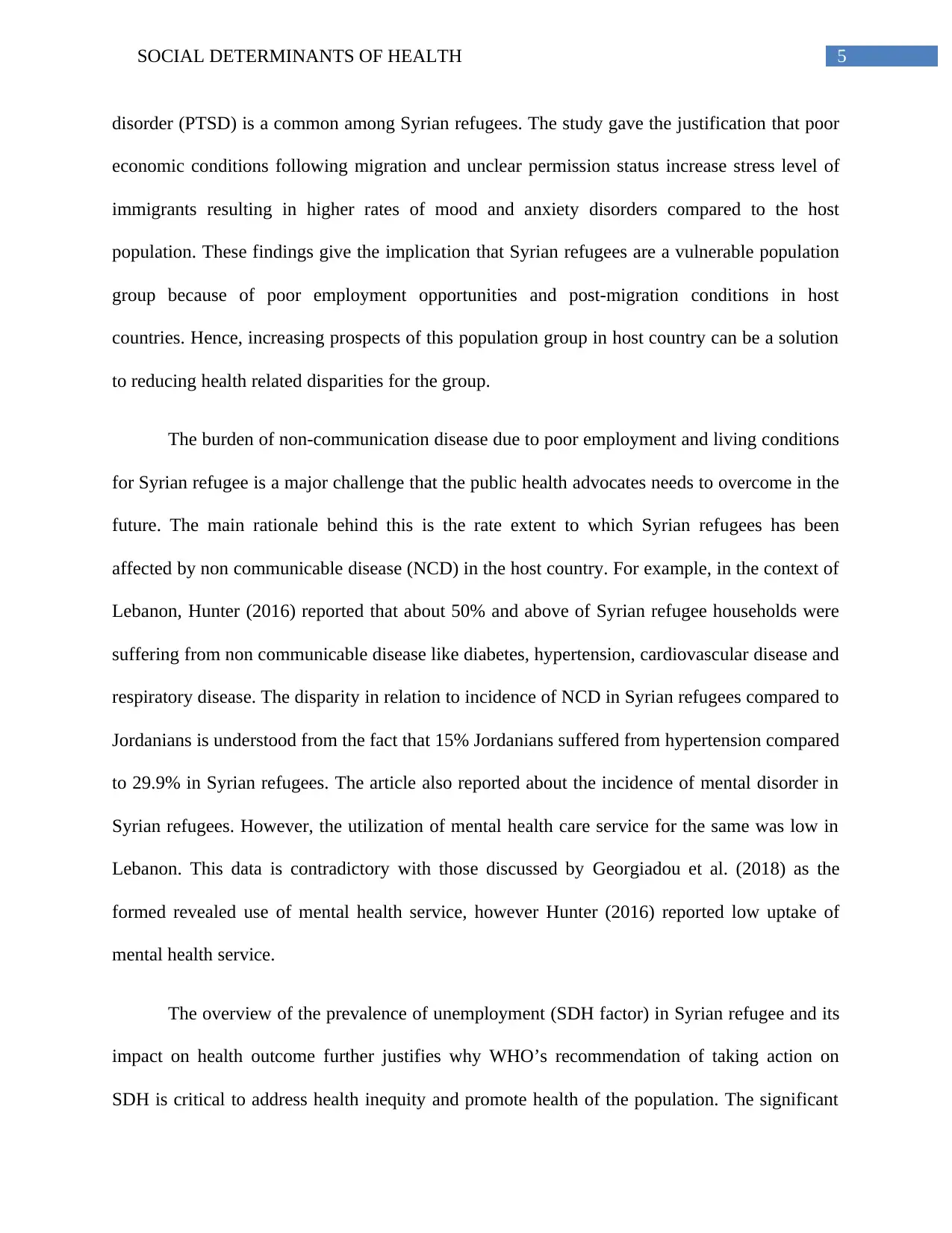
5SOCIAL DETERMINANTS OF HEALTH
disorder (PTSD) is a common among Syrian refugees. The study gave the justification that poor
economic conditions following migration and unclear permission status increase stress level of
immigrants resulting in higher rates of mood and anxiety disorders compared to the host
population. These findings give the implication that Syrian refugees are a vulnerable population
group because of poor employment opportunities and post-migration conditions in host
countries. Hence, increasing prospects of this population group in host country can be a solution
to reducing health related disparities for the group.
The burden of non-communication disease due to poor employment and living conditions
for Syrian refugee is a major challenge that the public health advocates needs to overcome in the
future. The main rationale behind this is the rate extent to which Syrian refugees has been
affected by non communicable disease (NCD) in the host country. For example, in the context of
Lebanon, Hunter (2016) reported that about 50% and above of Syrian refugee households were
suffering from non communicable disease like diabetes, hypertension, cardiovascular disease and
respiratory disease. The disparity in relation to incidence of NCD in Syrian refugees compared to
Jordanians is understood from the fact that 15% Jordanians suffered from hypertension compared
to 29.9% in Syrian refugees. The article also reported about the incidence of mental disorder in
Syrian refugees. However, the utilization of mental health care service for the same was low in
Lebanon. This data is contradictory with those discussed by Georgiadou et al. (2018) as the
formed revealed use of mental health service, however Hunter (2016) reported low uptake of
mental health service.
The overview of the prevalence of unemployment (SDH factor) in Syrian refugee and its
impact on health outcome further justifies why WHO’s recommendation of taking action on
SDH is critical to address health inequity and promote health of the population. The significant
disorder (PTSD) is a common among Syrian refugees. The study gave the justification that poor
economic conditions following migration and unclear permission status increase stress level of
immigrants resulting in higher rates of mood and anxiety disorders compared to the host
population. These findings give the implication that Syrian refugees are a vulnerable population
group because of poor employment opportunities and post-migration conditions in host
countries. Hence, increasing prospects of this population group in host country can be a solution
to reducing health related disparities for the group.
The burden of non-communication disease due to poor employment and living conditions
for Syrian refugee is a major challenge that the public health advocates needs to overcome in the
future. The main rationale behind this is the rate extent to which Syrian refugees has been
affected by non communicable disease (NCD) in the host country. For example, in the context of
Lebanon, Hunter (2016) reported that about 50% and above of Syrian refugee households were
suffering from non communicable disease like diabetes, hypertension, cardiovascular disease and
respiratory disease. The disparity in relation to incidence of NCD in Syrian refugees compared to
Jordanians is understood from the fact that 15% Jordanians suffered from hypertension compared
to 29.9% in Syrian refugees. The article also reported about the incidence of mental disorder in
Syrian refugees. However, the utilization of mental health care service for the same was low in
Lebanon. This data is contradictory with those discussed by Georgiadou et al. (2018) as the
formed revealed use of mental health service, however Hunter (2016) reported low uptake of
mental health service.
The overview of the prevalence of unemployment (SDH factor) in Syrian refugee and its
impact on health outcome further justifies why WHO’s recommendation of taking action on
SDH is critical to address health inequity and promote health of the population. The significant
⊘ This is a preview!⊘
Do you want full access?
Subscribe today to unlock all pages.

Trusted by 1+ million students worldwide
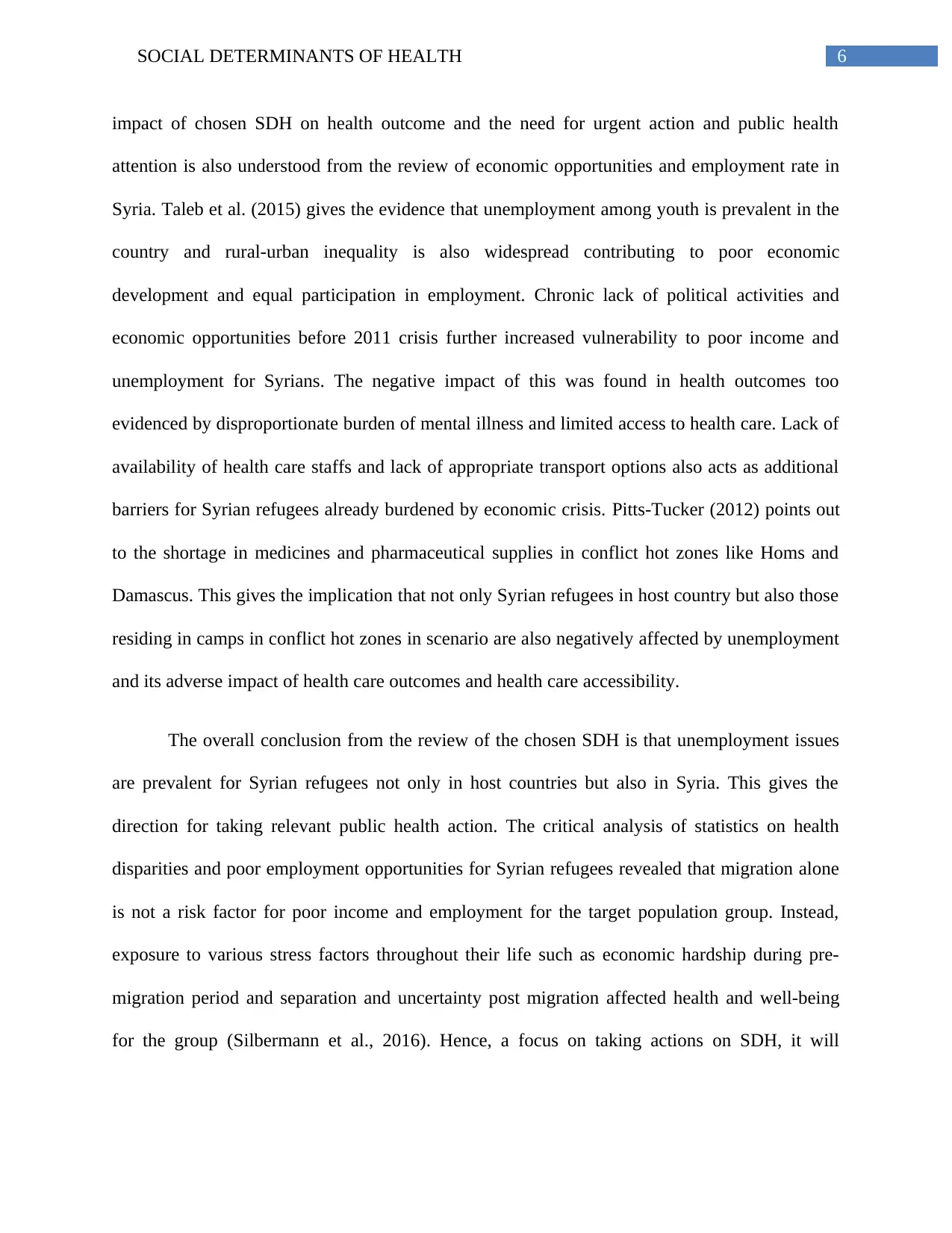
6SOCIAL DETERMINANTS OF HEALTH
impact of chosen SDH on health outcome and the need for urgent action and public health
attention is also understood from the review of economic opportunities and employment rate in
Syria. Taleb et al. (2015) gives the evidence that unemployment among youth is prevalent in the
country and rural-urban inequality is also widespread contributing to poor economic
development and equal participation in employment. Chronic lack of political activities and
economic opportunities before 2011 crisis further increased vulnerability to poor income and
unemployment for Syrians. The negative impact of this was found in health outcomes too
evidenced by disproportionate burden of mental illness and limited access to health care. Lack of
availability of health care staffs and lack of appropriate transport options also acts as additional
barriers for Syrian refugees already burdened by economic crisis. Pitts-Tucker (2012) points out
to the shortage in medicines and pharmaceutical supplies in conflict hot zones like Homs and
Damascus. This gives the implication that not only Syrian refugees in host country but also those
residing in camps in conflict hot zones in scenario are also negatively affected by unemployment
and its adverse impact of health care outcomes and health care accessibility.
The overall conclusion from the review of the chosen SDH is that unemployment issues
are prevalent for Syrian refugees not only in host countries but also in Syria. This gives the
direction for taking relevant public health action. The critical analysis of statistics on health
disparities and poor employment opportunities for Syrian refugees revealed that migration alone
is not a risk factor for poor income and employment for the target population group. Instead,
exposure to various stress factors throughout their life such as economic hardship during pre-
migration period and separation and uncertainty post migration affected health and well-being
for the group (Silbermann et al., 2016). Hence, a focus on taking actions on SDH, it will
impact of chosen SDH on health outcome and the need for urgent action and public health
attention is also understood from the review of economic opportunities and employment rate in
Syria. Taleb et al. (2015) gives the evidence that unemployment among youth is prevalent in the
country and rural-urban inequality is also widespread contributing to poor economic
development and equal participation in employment. Chronic lack of political activities and
economic opportunities before 2011 crisis further increased vulnerability to poor income and
unemployment for Syrians. The negative impact of this was found in health outcomes too
evidenced by disproportionate burden of mental illness and limited access to health care. Lack of
availability of health care staffs and lack of appropriate transport options also acts as additional
barriers for Syrian refugees already burdened by economic crisis. Pitts-Tucker (2012) points out
to the shortage in medicines and pharmaceutical supplies in conflict hot zones like Homs and
Damascus. This gives the implication that not only Syrian refugees in host country but also those
residing in camps in conflict hot zones in scenario are also negatively affected by unemployment
and its adverse impact of health care outcomes and health care accessibility.
The overall conclusion from the review of the chosen SDH is that unemployment issues
are prevalent for Syrian refugees not only in host countries but also in Syria. This gives the
direction for taking relevant public health action. The critical analysis of statistics on health
disparities and poor employment opportunities for Syrian refugees revealed that migration alone
is not a risk factor for poor income and employment for the target population group. Instead,
exposure to various stress factors throughout their life such as economic hardship during pre-
migration period and separation and uncertainty post migration affected health and well-being
for the group (Silbermann et al., 2016). Hence, a focus on taking actions on SDH, it will
Paraphrase This Document
Need a fresh take? Get an instant paraphrase of this document with our AI Paraphraser
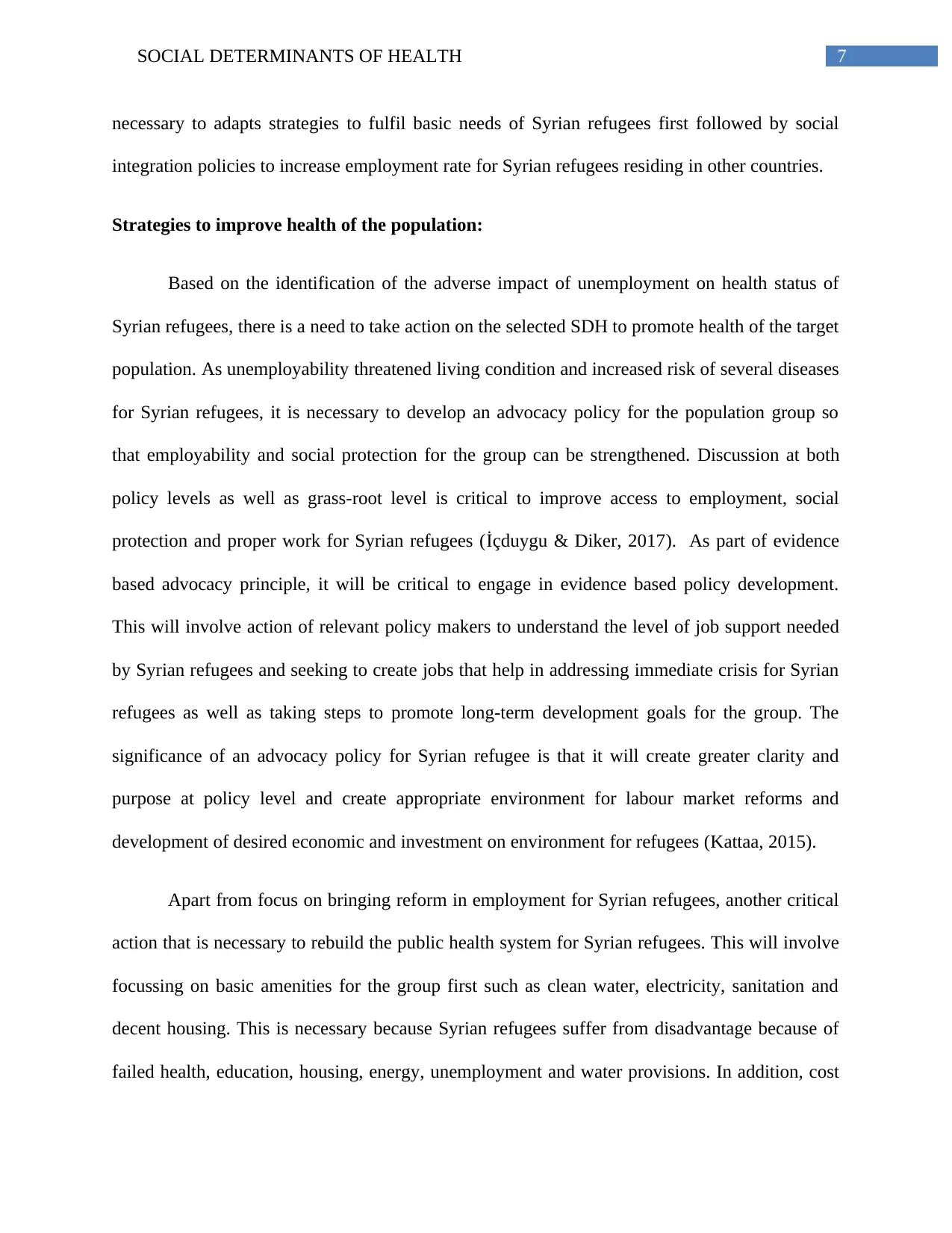
7SOCIAL DETERMINANTS OF HEALTH
necessary to adapts strategies to fulfil basic needs of Syrian refugees first followed by social
integration policies to increase employment rate for Syrian refugees residing in other countries.
Strategies to improve health of the population:
Based on the identification of the adverse impact of unemployment on health status of
Syrian refugees, there is a need to take action on the selected SDH to promote health of the target
population. As unemployability threatened living condition and increased risk of several diseases
for Syrian refugees, it is necessary to develop an advocacy policy for the population group so
that employability and social protection for the group can be strengthened. Discussion at both
policy levels as well as grass-root level is critical to improve access to employment, social
protection and proper work for Syrian refugees (İçduygu & Diker, 2017). As part of evidence
based advocacy principle, it will be critical to engage in evidence based policy development.
This will involve action of relevant policy makers to understand the level of job support needed
by Syrian refugees and seeking to create jobs that help in addressing immediate crisis for Syrian
refugees as well as taking steps to promote long-term development goals for the group. The
significance of an advocacy policy for Syrian refugee is that it will create greater clarity and
purpose at policy level and create appropriate environment for labour market reforms and
development of desired economic and investment on environment for refugees (Kattaa, 2015).
Apart from focus on bringing reform in employment for Syrian refugees, another critical
action that is necessary to rebuild the public health system for Syrian refugees. This will involve
focussing on basic amenities for the group first such as clean water, electricity, sanitation and
decent housing. This is necessary because Syrian refugees suffer from disadvantage because of
failed health, education, housing, energy, unemployment and water provisions. In addition, cost
necessary to adapts strategies to fulfil basic needs of Syrian refugees first followed by social
integration policies to increase employment rate for Syrian refugees residing in other countries.
Strategies to improve health of the population:
Based on the identification of the adverse impact of unemployment on health status of
Syrian refugees, there is a need to take action on the selected SDH to promote health of the target
population. As unemployability threatened living condition and increased risk of several diseases
for Syrian refugees, it is necessary to develop an advocacy policy for the population group so
that employability and social protection for the group can be strengthened. Discussion at both
policy levels as well as grass-root level is critical to improve access to employment, social
protection and proper work for Syrian refugees (İçduygu & Diker, 2017). As part of evidence
based advocacy principle, it will be critical to engage in evidence based policy development.
This will involve action of relevant policy makers to understand the level of job support needed
by Syrian refugees and seeking to create jobs that help in addressing immediate crisis for Syrian
refugees as well as taking steps to promote long-term development goals for the group. The
significance of an advocacy policy for Syrian refugee is that it will create greater clarity and
purpose at policy level and create appropriate environment for labour market reforms and
development of desired economic and investment on environment for refugees (Kattaa, 2015).
Apart from focus on bringing reform in employment for Syrian refugees, another critical
action that is necessary to rebuild the public health system for Syrian refugees. This will involve
focussing on basic amenities for the group first such as clean water, electricity, sanitation and
decent housing. This is necessary because Syrian refugees suffer from disadvantage because of
failed health, education, housing, energy, unemployment and water provisions. In addition, cost
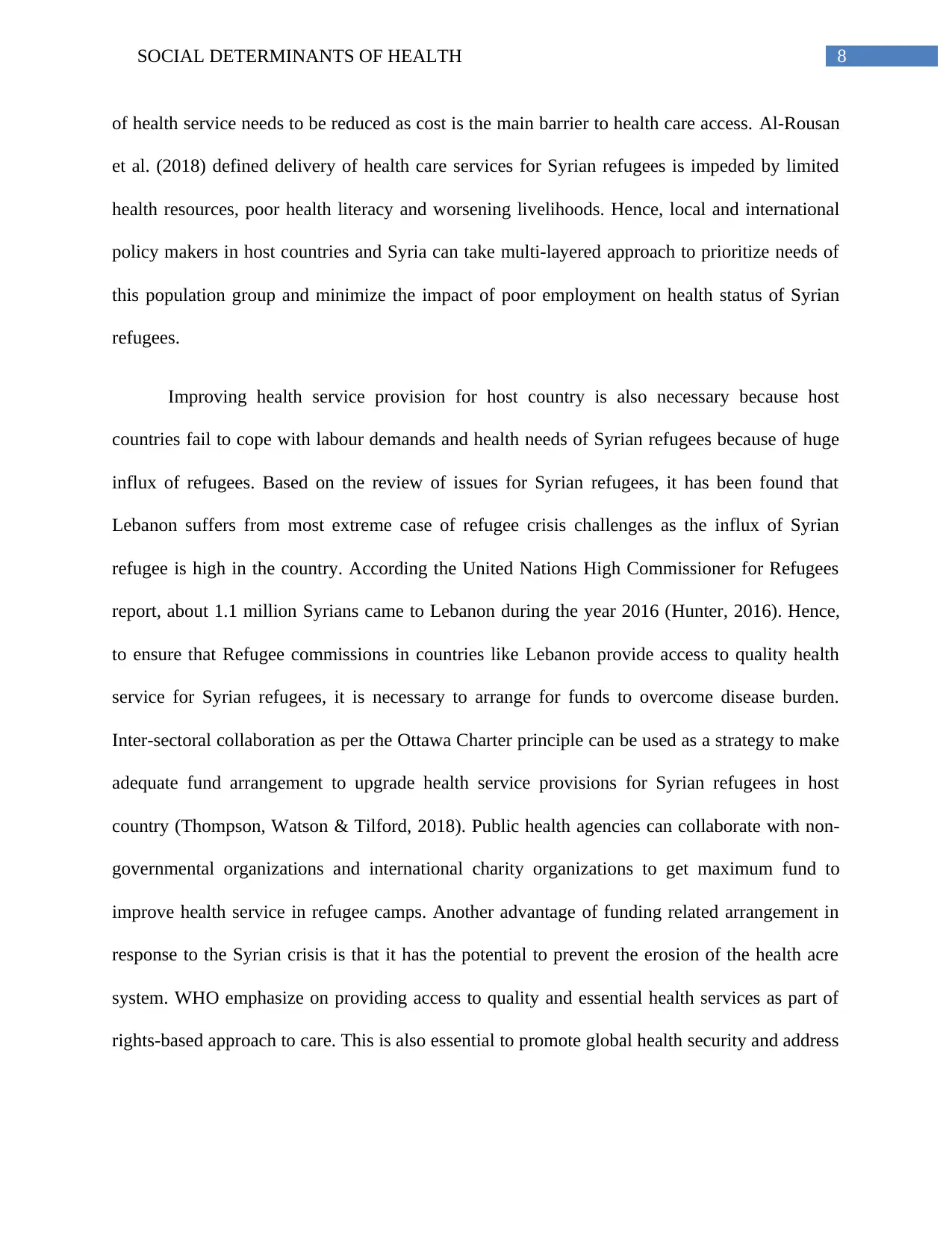
8SOCIAL DETERMINANTS OF HEALTH
of health service needs to be reduced as cost is the main barrier to health care access. Al-Rousan
et al. (2018) defined delivery of health care services for Syrian refugees is impeded by limited
health resources, poor health literacy and worsening livelihoods. Hence, local and international
policy makers in host countries and Syria can take multi-layered approach to prioritize needs of
this population group and minimize the impact of poor employment on health status of Syrian
refugees.
Improving health service provision for host country is also necessary because host
countries fail to cope with labour demands and health needs of Syrian refugees because of huge
influx of refugees. Based on the review of issues for Syrian refugees, it has been found that
Lebanon suffers from most extreme case of refugee crisis challenges as the influx of Syrian
refugee is high in the country. According the United Nations High Commissioner for Refugees
report, about 1.1 million Syrians came to Lebanon during the year 2016 (Hunter, 2016). Hence,
to ensure that Refugee commissions in countries like Lebanon provide access to quality health
service for Syrian refugees, it is necessary to arrange for funds to overcome disease burden.
Inter-sectoral collaboration as per the Ottawa Charter principle can be used as a strategy to make
adequate fund arrangement to upgrade health service provisions for Syrian refugees in host
country (Thompson, Watson & Tilford, 2018). Public health agencies can collaborate with non-
governmental organizations and international charity organizations to get maximum fund to
improve health service in refugee camps. Another advantage of funding related arrangement in
response to the Syrian crisis is that it has the potential to prevent the erosion of the health acre
system. WHO emphasize on providing access to quality and essential health services as part of
rights-based approach to care. This is also essential to promote global health security and address
of health service needs to be reduced as cost is the main barrier to health care access. Al-Rousan
et al. (2018) defined delivery of health care services for Syrian refugees is impeded by limited
health resources, poor health literacy and worsening livelihoods. Hence, local and international
policy makers in host countries and Syria can take multi-layered approach to prioritize needs of
this population group and minimize the impact of poor employment on health status of Syrian
refugees.
Improving health service provision for host country is also necessary because host
countries fail to cope with labour demands and health needs of Syrian refugees because of huge
influx of refugees. Based on the review of issues for Syrian refugees, it has been found that
Lebanon suffers from most extreme case of refugee crisis challenges as the influx of Syrian
refugee is high in the country. According the United Nations High Commissioner for Refugees
report, about 1.1 million Syrians came to Lebanon during the year 2016 (Hunter, 2016). Hence,
to ensure that Refugee commissions in countries like Lebanon provide access to quality health
service for Syrian refugees, it is necessary to arrange for funds to overcome disease burden.
Inter-sectoral collaboration as per the Ottawa Charter principle can be used as a strategy to make
adequate fund arrangement to upgrade health service provisions for Syrian refugees in host
country (Thompson, Watson & Tilford, 2018). Public health agencies can collaborate with non-
governmental organizations and international charity organizations to get maximum fund to
improve health service in refugee camps. Another advantage of funding related arrangement in
response to the Syrian crisis is that it has the potential to prevent the erosion of the health acre
system. WHO emphasize on providing access to quality and essential health services as part of
rights-based approach to care. This is also essential to promote global health security and address
⊘ This is a preview!⊘
Do you want full access?
Subscribe today to unlock all pages.

Trusted by 1+ million students worldwide
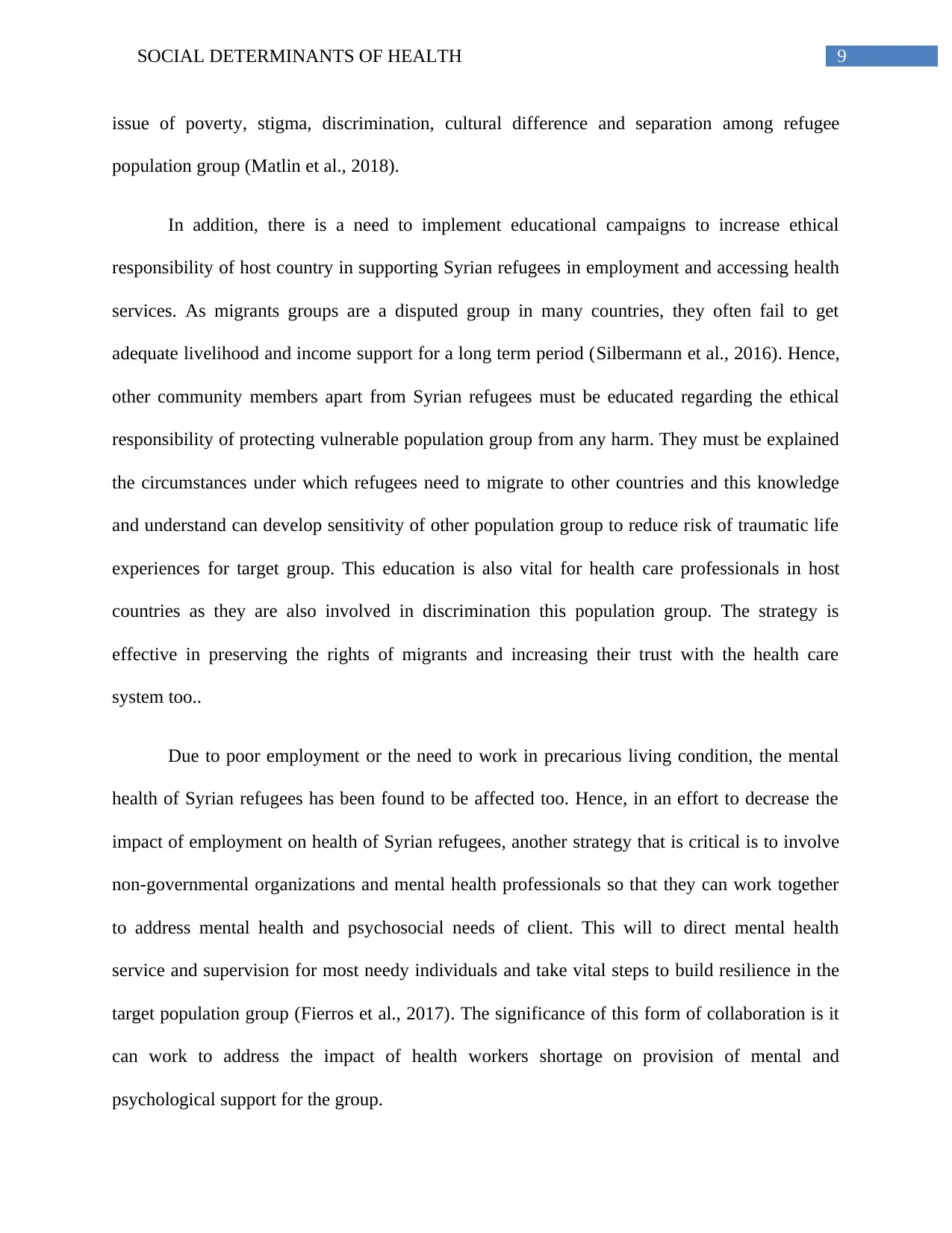
9SOCIAL DETERMINANTS OF HEALTH
issue of poverty, stigma, discrimination, cultural difference and separation among refugee
population group (Matlin et al., 2018).
In addition, there is a need to implement educational campaigns to increase ethical
responsibility of host country in supporting Syrian refugees in employment and accessing health
services. As migrants groups are a disputed group in many countries, they often fail to get
adequate livelihood and income support for a long term period (Silbermann et al., 2016). Hence,
other community members apart from Syrian refugees must be educated regarding the ethical
responsibility of protecting vulnerable population group from any harm. They must be explained
the circumstances under which refugees need to migrate to other countries and this knowledge
and understand can develop sensitivity of other population group to reduce risk of traumatic life
experiences for target group. This education is also vital for health care professionals in host
countries as they are also involved in discrimination this population group. The strategy is
effective in preserving the rights of migrants and increasing their trust with the health care
system too..
Due to poor employment or the need to work in precarious living condition, the mental
health of Syrian refugees has been found to be affected too. Hence, in an effort to decrease the
impact of employment on health of Syrian refugees, another strategy that is critical is to involve
non-governmental organizations and mental health professionals so that they can work together
to address mental health and psychosocial needs of client. This will to direct mental health
service and supervision for most needy individuals and take vital steps to build resilience in the
target population group (Fierros et al., 2017). The significance of this form of collaboration is it
can work to address the impact of health workers shortage on provision of mental and
psychological support for the group.
issue of poverty, stigma, discrimination, cultural difference and separation among refugee
population group (Matlin et al., 2018).
In addition, there is a need to implement educational campaigns to increase ethical
responsibility of host country in supporting Syrian refugees in employment and accessing health
services. As migrants groups are a disputed group in many countries, they often fail to get
adequate livelihood and income support for a long term period (Silbermann et al., 2016). Hence,
other community members apart from Syrian refugees must be educated regarding the ethical
responsibility of protecting vulnerable population group from any harm. They must be explained
the circumstances under which refugees need to migrate to other countries and this knowledge
and understand can develop sensitivity of other population group to reduce risk of traumatic life
experiences for target group. This education is also vital for health care professionals in host
countries as they are also involved in discrimination this population group. The strategy is
effective in preserving the rights of migrants and increasing their trust with the health care
system too..
Due to poor employment or the need to work in precarious living condition, the mental
health of Syrian refugees has been found to be affected too. Hence, in an effort to decrease the
impact of employment on health of Syrian refugees, another strategy that is critical is to involve
non-governmental organizations and mental health professionals so that they can work together
to address mental health and psychosocial needs of client. This will to direct mental health
service and supervision for most needy individuals and take vital steps to build resilience in the
target population group (Fierros et al., 2017). The significance of this form of collaboration is it
can work to address the impact of health workers shortage on provision of mental and
psychological support for the group.
Paraphrase This Document
Need a fresh take? Get an instant paraphrase of this document with our AI Paraphraser
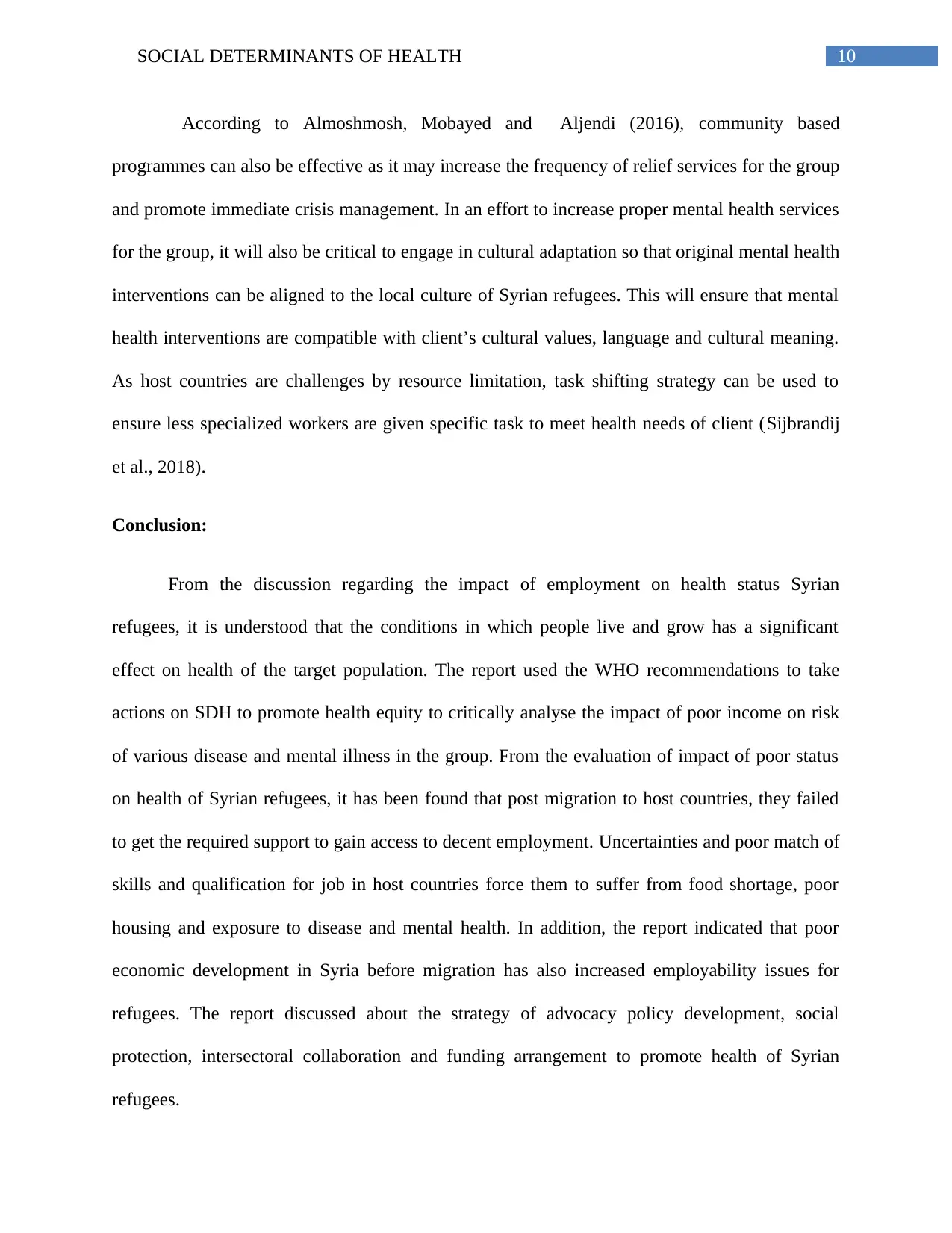
10SOCIAL DETERMINANTS OF HEALTH
According to Almoshmosh, Mobayed and Aljendi (2016), community based
programmes can also be effective as it may increase the frequency of relief services for the group
and promote immediate crisis management. In an effort to increase proper mental health services
for the group, it will also be critical to engage in cultural adaptation so that original mental health
interventions can be aligned to the local culture of Syrian refugees. This will ensure that mental
health interventions are compatible with client’s cultural values, language and cultural meaning.
As host countries are challenges by resource limitation, task shifting strategy can be used to
ensure less specialized workers are given specific task to meet health needs of client (Sijbrandij
et al., 2018).
Conclusion:
From the discussion regarding the impact of employment on health status Syrian
refugees, it is understood that the conditions in which people live and grow has a significant
effect on health of the target population. The report used the WHO recommendations to take
actions on SDH to promote health equity to critically analyse the impact of poor income on risk
of various disease and mental illness in the group. From the evaluation of impact of poor status
on health of Syrian refugees, it has been found that post migration to host countries, they failed
to get the required support to gain access to decent employment. Uncertainties and poor match of
skills and qualification for job in host countries force them to suffer from food shortage, poor
housing and exposure to disease and mental health. In addition, the report indicated that poor
economic development in Syria before migration has also increased employability issues for
refugees. The report discussed about the strategy of advocacy policy development, social
protection, intersectoral collaboration and funding arrangement to promote health of Syrian
refugees.
According to Almoshmosh, Mobayed and Aljendi (2016), community based
programmes can also be effective as it may increase the frequency of relief services for the group
and promote immediate crisis management. In an effort to increase proper mental health services
for the group, it will also be critical to engage in cultural adaptation so that original mental health
interventions can be aligned to the local culture of Syrian refugees. This will ensure that mental
health interventions are compatible with client’s cultural values, language and cultural meaning.
As host countries are challenges by resource limitation, task shifting strategy can be used to
ensure less specialized workers are given specific task to meet health needs of client (Sijbrandij
et al., 2018).
Conclusion:
From the discussion regarding the impact of employment on health status Syrian
refugees, it is understood that the conditions in which people live and grow has a significant
effect on health of the target population. The report used the WHO recommendations to take
actions on SDH to promote health equity to critically analyse the impact of poor income on risk
of various disease and mental illness in the group. From the evaluation of impact of poor status
on health of Syrian refugees, it has been found that post migration to host countries, they failed
to get the required support to gain access to decent employment. Uncertainties and poor match of
skills and qualification for job in host countries force them to suffer from food shortage, poor
housing and exposure to disease and mental health. In addition, the report indicated that poor
economic development in Syria before migration has also increased employability issues for
refugees. The report discussed about the strategy of advocacy policy development, social
protection, intersectoral collaboration and funding arrangement to promote health of Syrian
refugees.
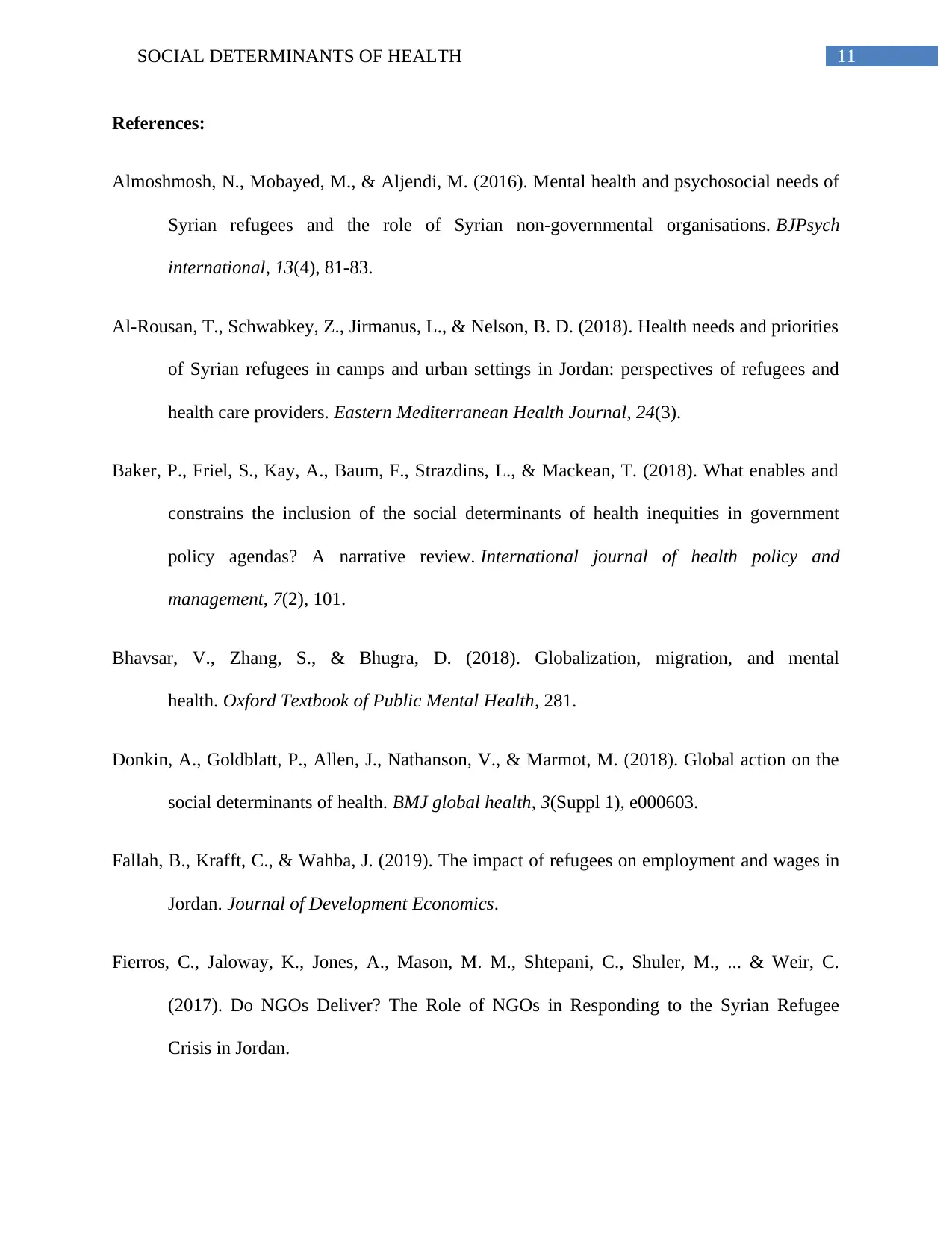
11SOCIAL DETERMINANTS OF HEALTH
References:
Almoshmosh, N., Mobayed, M., & Aljendi, M. (2016). Mental health and psychosocial needs of
Syrian refugees and the role of Syrian non-governmental organisations. BJPsych
international, 13(4), 81-83.
Al-Rousan, T., Schwabkey, Z., Jirmanus, L., & Nelson, B. D. (2018). Health needs and priorities
of Syrian refugees in camps and urban settings in Jordan: perspectives of refugees and
health care providers. Eastern Mediterranean Health Journal, 24(3).
Baker, P., Friel, S., Kay, A., Baum, F., Strazdins, L., & Mackean, T. (2018). What enables and
constrains the inclusion of the social determinants of health inequities in government
policy agendas? A narrative review. International journal of health policy and
management, 7(2), 101.
Bhavsar, V., Zhang, S., & Bhugra, D. (2018). Globalization, migration, and mental
health. Oxford Textbook of Public Mental Health, 281.
Donkin, A., Goldblatt, P., Allen, J., Nathanson, V., & Marmot, M. (2018). Global action on the
social determinants of health. BMJ global health, 3(Suppl 1), e000603.
Fallah, B., Krafft, C., & Wahba, J. (2019). The impact of refugees on employment and wages in
Jordan. Journal of Development Economics.
Fierros, C., Jaloway, K., Jones, A., Mason, M. M., Shtepani, C., Shuler, M., ... & Weir, C.
(2017). Do NGOs Deliver? The Role of NGOs in Responding to the Syrian Refugee
Crisis in Jordan.
References:
Almoshmosh, N., Mobayed, M., & Aljendi, M. (2016). Mental health and psychosocial needs of
Syrian refugees and the role of Syrian non-governmental organisations. BJPsych
international, 13(4), 81-83.
Al-Rousan, T., Schwabkey, Z., Jirmanus, L., & Nelson, B. D. (2018). Health needs and priorities
of Syrian refugees in camps and urban settings in Jordan: perspectives of refugees and
health care providers. Eastern Mediterranean Health Journal, 24(3).
Baker, P., Friel, S., Kay, A., Baum, F., Strazdins, L., & Mackean, T. (2018). What enables and
constrains the inclusion of the social determinants of health inequities in government
policy agendas? A narrative review. International journal of health policy and
management, 7(2), 101.
Bhavsar, V., Zhang, S., & Bhugra, D. (2018). Globalization, migration, and mental
health. Oxford Textbook of Public Mental Health, 281.
Donkin, A., Goldblatt, P., Allen, J., Nathanson, V., & Marmot, M. (2018). Global action on the
social determinants of health. BMJ global health, 3(Suppl 1), e000603.
Fallah, B., Krafft, C., & Wahba, J. (2019). The impact of refugees on employment and wages in
Jordan. Journal of Development Economics.
Fierros, C., Jaloway, K., Jones, A., Mason, M. M., Shtepani, C., Shuler, M., ... & Weir, C.
(2017). Do NGOs Deliver? The Role of NGOs in Responding to the Syrian Refugee
Crisis in Jordan.
⊘ This is a preview!⊘
Do you want full access?
Subscribe today to unlock all pages.

Trusted by 1+ million students worldwide
1 out of 15
Related Documents
Your All-in-One AI-Powered Toolkit for Academic Success.
+13062052269
info@desklib.com
Available 24*7 on WhatsApp / Email
![[object Object]](/_next/static/media/star-bottom.7253800d.svg)
Unlock your academic potential
Copyright © 2020–2025 A2Z Services. All Rights Reserved. Developed and managed by ZUCOL.





